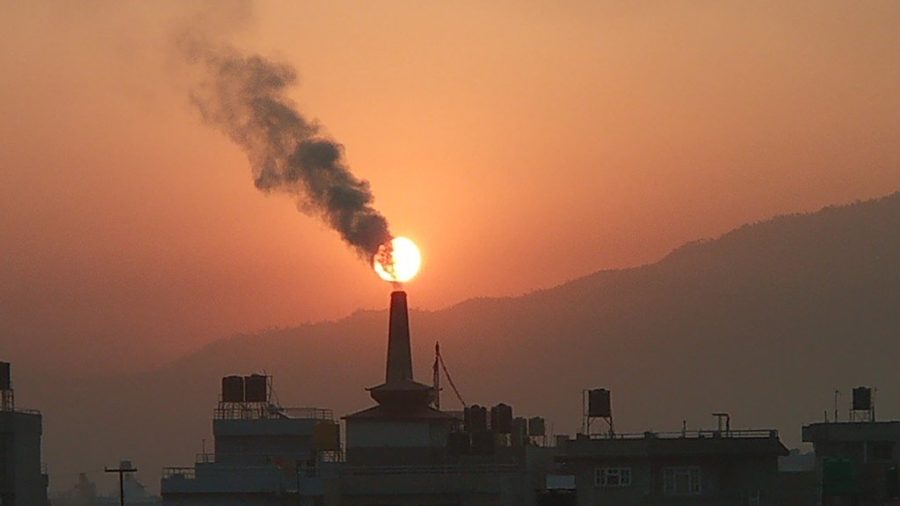COVID-19 is a respiratory illness, so it’s not surprising that exposure to poor air quality worsens patient outcomes. But how does air pollution affect people who are vaccinated?
To answer that question, a team of researchers analyzed data from more than 50,000 COVID-19 patients across Southern California. By comparing publicly available air quality monitoring data with deidentified patient medical records, they first established that regardless of air pollution exposure, vaccines go a long way in reducing COVID-19 hospitalizations.
“Fully vaccinated people had almost 90% reduced risk of COVID hospitalization, and even partially vaccinated people had about 50% less risk,” said Zhanghua Chen, PhD, assistant professor of population and public health sciences at the Keck School of Medicine of USC and co-first author of the study.
But air pollutants—in particular fine particles (PM2.5) and nitrogen dioxide (NO2)—are still harmful. Even among people who were vaccinated, exposure to those two pollutants over the short or long term increased the risk of hospitalization up to 30%.
“Among vaccinated people, the detrimental effect of air pollution exposure is a little smaller, compared to people who were not vaccinated,” Chen said. “But that difference is not statistically significant.”
The study was just published in the American Journal of Respiratory and Critical Care Medicine. The research builds on the team’s earlier findings, which helped establish the link between air pollution exposure and COVID-19 severity.
“These findings are important because they show that, while COVID-19 vaccines are successful at reducing the risk of hospitalization, people who are vaccinated and exposed to polluted air are still at increased risk for worse outcomes than vaccinated people not exposed to air pollution,” said corresponding author Anny Xiang, PhD, MS, a senior research scientist at Kaiser Permanente Southern California’s (KPSC) Department of Research & Evaluation.
Short-term and long-term exposures
The researchers analyzed medical records, which were deidentified to protect patient privacy, from KPSC patients. Across the health care network, 50,010 patients, ages 12 and up, were diagnosed with COVID-19 in July or August of 2021, when the Delta variant was circulating and many people had been vaccinated.
Then, the researchers calculated estimated air pollution exposure levels for each participant based on residential addresses. They looked at average PM2.5, NO2, and ozone (O3) levels during the one-month and one-year periods before each patient received a COVID-19 diagnosis.
“We investigated both long-term and short-term air pollution exposure, which may influence COVID-19 severity through different mechanisms,” said Chen.
Over the long term, pollution is linked to increases in cardiovascular and lung diseases, which are in turn linked to more severe COVID-19 symptoms. In the short term, air pollution exposure may worsen inflammation in the lungs and could even alter the immune response to the virus.
Chen, Xiang, and their colleagues found that among 30,912 people who were unvaccinated, high short-term PM2.5 exposure increased the risk of COVID-19 hospitalizations by 13%, while long-term exposure increased the risk by 24%. For NO2, short-term exposure raised hospitalization risk by 14% and long-term exposure raised the risk by 22%. The pollutant O3 was not significantly associated with COVID-19 hospitalizations.
For those who were partially or fully vaccinated, the hospitalization risks related to air pollution exposure were slightly lower—but the difference was not statistically significant.
Using data from medical records and neighborhood-level databases, the researchers were able to control for the effects of vaccination status, age, sex, race/ethnicity, health insurance status, body mass index, smoking history, health comorbidities, education level, income level and population density.
Improving indoor air quality
The findings suggest that in order to reduce severe cases of COVID-19, we need to improve air quality. This spring, the Biden Administration launched the Clean Air in Buildings Challenge, an effort to install high-efficiency particulate absorbing (HEPA) filters in schools and other public buildings.
Chen recently received funding to conduct clinical trials of HEPA filters to determine whether they reduce the risk of diabetes and cardiovascular disease. Her team will also continue their collaboration with KPSC to study the direct impacts of indoor air purifiers on COVID-19 patients.
About this study
In addition to Chen and Xiang, the study’s other authors are Brian Z. Huang and Frank D. Gilliland of the Department of Preventive Medicine, Keck School of Medicine of USC; Margo A. Sidell, Ting Chow and Mayra P. Martinez of the Department of Research & Evaluation, Kaiser Permanente Southern California; and Fred Lurmann of Sonoma Technology, Inc.
This work was supported by the National Institute of Environmental Health Sciences at the National Institutes of Health [3R01ES029963-01] and the Keck School of Medicine of USC’s Department of Preventive Medicine COVID-19 Pandemic Research Center (CPRC).
About Keck School of Medicine of USC
Founded in 1885, the Keck School of Medicine of USC is one of the nation’s leading medical institutions, known for innovative patient care, scientific discovery, education and community service. Medical and graduate students work closely with world-renowned faculty and receive hands-on training in one of the nation’s most diverse communities. They participate in cutting-edge research as they develop into tomorrow’s health leaders. The Keck School faculty are key participants in training of 1200 resident physicians across 70 specialty and subspecialty programs, thus playing a major role in the education of physicians practicing in Southern California.


